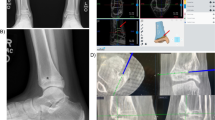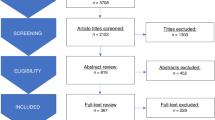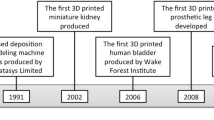Abstract
Overview
The goal of this study was to review the current application and status of three-dimensional printing for craniosynostosis surgery.
Methods
A literature review was performed using the PubMed/MEDLINE databases for studies published between 2010 and 2020. All studies demonstrating the utilization of three-dimensional printing for craniosynostosis surgery were included.
Results
A total of 15 studies were ultimately selected. This includes studies demonstrating novel three-dimensional simulation and printing workflows, studies utilizing three-dimensional printing for surgical simulation, as well as case reports describing prior experiences.
Conclusion
The incorporation of three-dimensional printing into the domain of craniosynostosis surgery has many potential benefits. This includes streamlining surgical planning, developing patient-specific template guides, enhancing residency training, as well as aiding in patient counseling. However, the current state of the literature remains in the validation stage. Further study with larger case series, direct comparisons with control groups, and prolonged follow-up times is necessary before more widespread implementation is justified.


Similar content being viewed by others
References
Governale LS (2015) Craniosynostosis. Pediatr Neurol 53(5):394–401. https://doi.org/10.1016/j.pediatrneurol.2015.07.006
Di Rocco F, Arnaud E, Renier D (2009) Evolution in the frequency of nonsyndromic craniosynostosis. J Neurosurg Pediatr. 4(1):21–25. https://doi.org/10.3171/2009.3.PEDS08355
Kajdic N, Spazzapan P, Velnar T (2018) Craniosynostosis - recognition, clinical characteristics, and treatment. Bosn J Basic Med Sci 18(2):110–116. https://doi.org/10.17305/bjbms.2017.2083
Alshomer F, AlFaqeeh F, Alariefy M, Altweijri I, Alhumsi T (2019) Low-cost desktop-based three-dimensional-printed patient-specific craniofacial models in surgical counseling, consent taking, and education of parent of craniosynostosis patients: a comparison with conventional visual explanation modalities. J Craniofac Surg 30(6):1652–1656. https://doi.org/10.1097/SCS.0000000000005401
Cheng D, Yuan M, Perera I, O’Connor A, Evins AI, Imahiyerobo T, Souweidane M, Hoffman C Developing a 3D composite training model for cranial remodeling. J Neurosurg Pediatr. Published online September 20, 2019:1–10. https://doi.org/10.3171/2019.6.PEDS18773
García-Mato D, Ochandiano S, García-Sevilla M, Navarro-Cuéllar C, Darriba-Allés JV, García-Leal R, Calvo-Haro JA, Pérez-Mañanes R, Salmerón JI, Pascau J (2019) Craniosynostosis surgery: workflow based on virtual surgical planning, intraoperative navigation and 3D printed patient-specific guides and templates. Sci Rep 9:17691. https://doi.org/10.1038/s41598-019-54148-4
Lobb DC, Cottler P, Dart D, Black JS (2019) The use of patient-specific three-dimensional printed surgical models enhances plastic surgery resident education in craniofacial surgery. J Craniofac Surg. 30(2):339–341. https://doi.org/10.1097/SCS.0000000000005322
Veeramani A, Singh A, DiLuna ML, Steinbacher DM (2019) Correction of sagittal synostosis using three-dimensional planning and maltese cross geometry. Plast Reconstr Surg 144(3):713–715. https://doi.org/10.1097/PRS.0000000000005980
Dumas BM, Nava A, Law H-Z, Smartt J, Derderian C, Seaward JR, Kane AA, Hallac RR (2019) Three-dimensional printing for craniofacial surgery: a single institution’s 5-year experience. Cleft Palate Craniofac J 56(6):729–734. https://doi.org/10.1177/1055665618798292
Day KM, Gabrick KS, Sargent LA (2018) Applications of computer technology in complex craniofacial reconstruction. Plast Reconstr Surg Glob Open 6(3):e1655. https://doi.org/10.1097/GOX.0000000000001655
Eastwood KW, Bodani VP, Haji FA, Looi T, Naguib HE, Drake JM (2018) Development of synthetic simulators for endoscope-assisted repair of metopic and sagittal craniosynostosis. J Neurosurg Pediatr 22(2):128–136. https://doi.org/10.3171/2018.2.PEDS18121
Ghizoni E, de Souza JPSAS, Raposo-Amaral CE, Denadai R, de Aquino HB, Raposo-Amaral CA, Joaquim AF, Tedeschi H, Bernardes LF, Jardini AL (2018) 3D-printed craniosynostosis model: new simulation surgical tool. World Neurosurg 109:356–361. https://doi.org/10.1016/j.wneu.2017.10.025
Kobets AJ, Ammar A, Nakhla J, Scoco A, Nasser R, Goodrich JT, Abbott R (2018) Virtual modeling, stereolithography, and intraoperative CT guidance for the optimization of sagittal synostosis reconstruction: a technical note. Childs Nerv Syst 34(5):965–970. https://doi.org/10.1007/s00381-018-3746-5
Borghi A, Rodgers W, Schievano S, Ponniah A, Jeelani O, Dunaway D (2018) Proof of concept study for the design, manufacturing, and testing of a patient-specific shape memory device for treatment of unicoronal craniosynostosis. J Craniofac Surg. 29(1):45–48. https://doi.org/10.1097/SCS.0000000000004025
LoPresti M, Daniels B, Buchanan EP, Monson L, Lam S (2017) Virtual surgical planning and 3D printing in repeat calvarial vault reconstruction for craniosynostosis: technical note. J Neurosurg Pediatr 19(4):490–494. https://doi.org/10.3171/2016.10.PEDS16301
Ni J, Yang B, Li B Reconstructive operation of nonsyndromic multiple-suture craniosynostosis based on precise virtual plan and prefabricated template. J Craniofac Surg. https://doi.org/10.1097/SCS.0000000000003784
Soleman J, Thieringer F, Beinemann J, Kunz C, Guzman R (2015) Computer-assisted virtual planning and surgical template fabrication for frontoorbital advancement. Neurosurg Focus 38(5):E5. https://doi.org/10.3171/2015.3.FOCUS14852
Steinbacher DM (2015) Three-Dimensional analysis and surgical planning in craniomaxillofacial surgery. J Oral Maxillofac Surg 73(12 Suppl):S40–S56. https://doi.org/10.1016/j.joms.2015.04.038
Dean D, Bookstein FL, Koneru S, Lee JH, Kamath J, Cutting CB, Hans M, Goldberg J (1998) Average African American three-dimensional computed tomography skull images: the potential clinical importance of ethnicity and sex. J Craniofac Surg. 9(4):348–358; discussion 359. https://doi.org/10.1097/00001665-199807000-00011
Mueller SK, Bleier BS (2018) Osteologic analysis of ethnic differences in supernumerary ethmoidal foramina: implications for endoscopic sinus and orbit surgery. Int Forum Allergy Rhinol 8(5):655–658. https://doi.org/10.1002/alr.22059
Author information
Authors and Affiliations
Corresponding author
Ethics declarations
Conflict of interest
The authors deny any conflicts of interest.
Additional information
Publisher’s note
Springer Nature remains neutral with regard to jurisdictional claims in published maps and institutional affiliations.
Rights and permissions
About this article
Cite this article
Soldozy, S., Yağmurlu, K., Akyeampong, D.K. et al. Three-dimensional printing and craniosynostosis surgery. Childs Nerv Syst 37, 2487–2495 (2021). https://doi.org/10.1007/s00381-021-05133-8
Received:
Accepted:
Published:
Issue Date:
DOI: https://doi.org/10.1007/s00381-021-05133-8




